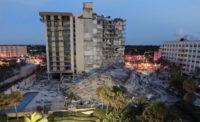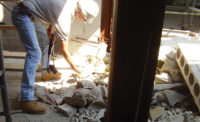The public has until May 16 to submit comments on the draft of the first U.S. consensus standard addressing disproportionate collapse of structures. The draft defines disproportionate collapse as “characterized by a pronounced disparity between the original cause and the ensuing collapse of a major part or the whole of a structure.”
Disproportionate collapses, which involve small triggers and result in major failures, are rare but high-consequence events, says Donald O. Dusenberry, a consulting forensic engineer and chair of the American Society of Civil Engineers-Structural Engineering Institute’s ASCE/SEI disproportionate collapse mitigation of building structures standard committee. Dusenberry is an ENR 2021 Top 25 Newsmaker for his effort leading the committee.
Work started in 2009 on the ASCE/SEI 76-XX Standard for Mitigation of Disproportionate Collapse Potential in Buildings and Other Structures. ASCE issued the draft for public comment on April 1. The comment period is open for a minimum of 45 days, per ASCE rules.
Need for Standard Long Debated
The need for a standard has long been debated, which is one reason why it took so long to produce the draft. “Some in the profession don’t feel it is necessary,” because disproportionate collapse is a low-probability event, says Bruce Ellingwood, a professor of civil engineering at Colorado State University and a committee member. That’s why the standard will not be applied to ordinary buildings, he adds.
After May 16, the disproportionate collapse committee, which has 50 volunteer members, will respond to the public comments and ballot any major changes subsequently made to the draft. Then, the ASCE codes and standards committee will review the process to ensure ASCE rules were followed, before approving the standard for publication, according to Jennifer Goupil, director of SEI codes, standards and technical initiatives.
The expectation is that the standard will be published by the end of the year, says Goupil. It could take longer, though, especially if there is a need for more than one more public ballot.
The purpose of the standard is to provide principles and minimum requirements to mitigate disproportionate collapse potential of new and existing buildings and other structures, according to ASCE. It provides minimum requirements for “planning, assessment, analysis, material selection, design and detailing, construction, and qualification testing to mitigate disproportionate collapse of new and existing buildings and other structures." The draft includes threat-specific and non-threat-specific methodologies and identifies direct design and indirect design approaches.
Performance-Based Approach
The standard calls for a performance-based approach to design, not a prescriptive one. “A building or structure can be subjected to loads outside of the design case,” which takes into account wind and seismic forces only, not loads from vehicle collisions, fires, bombs or other forces, says Ellingwood.
There are at least two strategies used to engineer a structure to minimize the likelihood of disproportionate collapse, says Dusenberry. One postulates the removal of one or several significant elements, such as columns, and the development of alternate load paths.
Another strategy is to isolate different structural systems, perhaps through expansion joints or other means. That strategy may be most useful in a long, low building, where the failure might propagate horizontally, says Dusenberry.
Dusenberry considers the 1990 sinking, during renovations, of 2,800 ft of the 6,600-ft-long Lacey V. Murrow Floating-Concrete Pontoon Bridge across Lake Washington in Washington state and the 1995 bombing of the Alfred P. Murrah Federal Building in Oklahoma City as examples of disproportionate collapse. He says it would be unwise to speculate about the failure last year at Champlain Towers South, in Surfside, Fla., but investigators are eyeing it as a possible disproportionate collapse.





Post a comment to this article
Report Abusive Comment